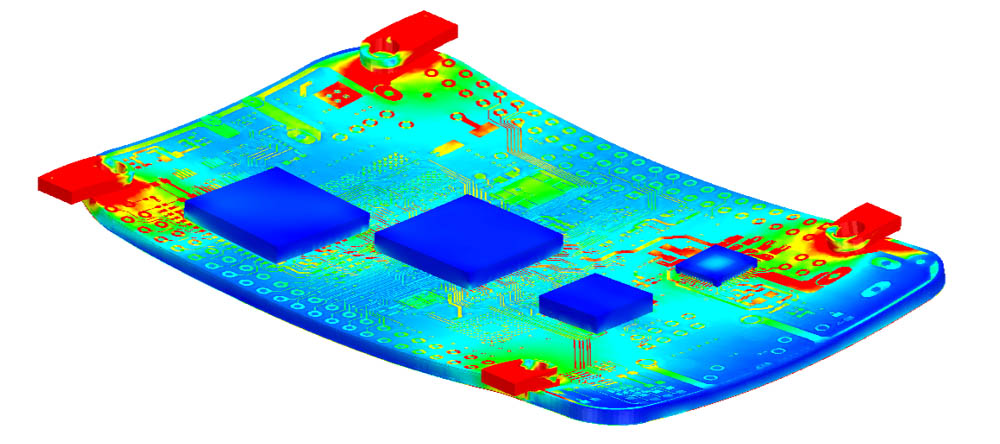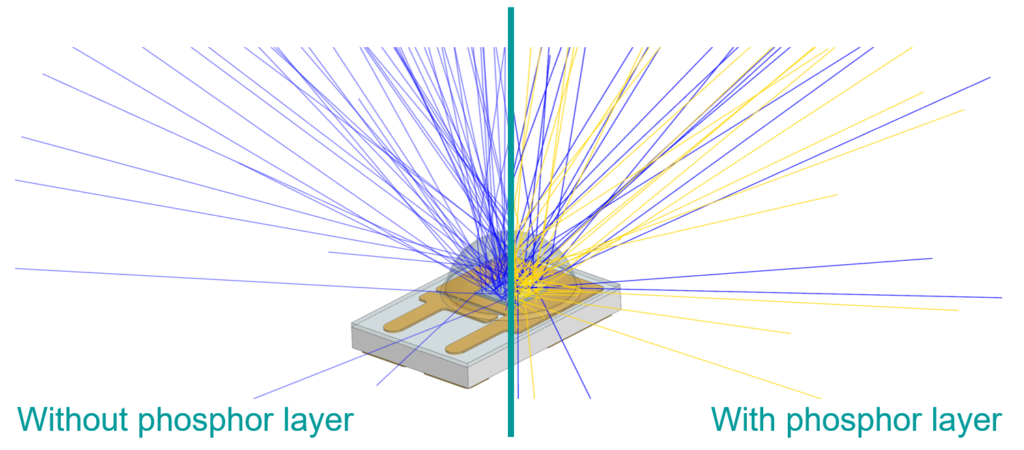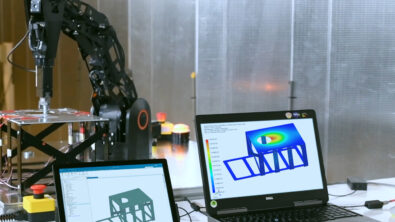Simcenter™ FLOEFD™ 2021.1: What’s New?

The latest release of CAD-embedded Simcenter FLOEFD 2021.1 has just been announced. Simcenter FLOEFD is a CAD-embedded computational fluid dynamics (CFD) solution and supports NX, Solid Edge, CATIA V5 and Creo. Due to its unique technology, it can reduce the overall simulation time by up to 75%. This new release provides a range of new features and enhancements, as well as 2 new add-on modules. The new capabilities featured in this version range from electromagnetic simulation and structural simulation, to joule heating in PCBs by co-simulation with HyperLynx from Siemens EDA and many other new capabilities. Let’s take a look at the list of new functionalities available in the latest release:
Simcenter FLOEFD EMAG Module
With this new module in Simcenter FLOEFD 2021.1, you can now simulate alternating current (AC) and electromagnetic (EM) (low frequency) effects. This module is based on the Simcenter MAGNET mesher and solver technology and allows for increased accuracy of thermal simulations by taking into account Ohmic and iron (core) losses due to AC and EM phenomena such as proximity, skin effect, etc. Transient and Time-harmonic (sinusoidal waveform) analysis is supported as well as permanent magnets. An electromagnetics analysis is defined together with a CFD analysis and a CFD-EM co-simulation takes place by exchanging the power (Ohmic and iron losses) and temperature fields.
To access this functionality, you will need the “Simcenter FLOEFD EMAG” module.

Simcenter FLOEFD Structural Module
With this new module in Simcenter FLOEFD 2021.1, you can perform linear static stress analyses and modal-frequency analyses. The range of analysis types in the FE solver includes: static response to loads, thermal expansion, and enforced deformation as well as determination of eigenvalues. A special Smart PCB FE model allows for accurate and time effective stress analysis of a PCB taking all the details of the PCB’s internal structure from an original EDA file into account, traces and vias are resolved without any simplification and without creating the explicit geometry in CAD. Direct integration of structural analysis and CFD allows you to carry out complicated simulations for structural analysis by using the CFD results automatically, which does not require additional conversion of CFD results to external finite element analysis (FEA) software. Simcenter FLOEFD pressure and temperature results are automatically applied as loads for structural analysis, thus minimizing effort and time. In addition, a Simcenter FLOEFD Structural project can be saved as a Simcenter Nastran project for further simulation of complex structural analysis not available in Simcenter FLOEFD.
To access this functionality, you will need the “Simcenter FLOEFD Structural” module.

New Electronics Cooling Specific Functionality
Simcenter FLOEFD 2021.1 has a handful of new features specifically for electronics cooling applications:
Joule Heating in PCBs: Simcenter FLOEFD-HyperLynx Co-Simulation
The Smart PCB model can now simulate Joule heating via the Simcenter FLOEFD-HyperLynx (v2.8 Update 1 and newer) co-simulation. Simcenter FLOEFD can take a power map from a HyperLynx DC drop simulation and perform a thermal analysis. Then it can return a temperature map to HyperLynx to update the electrical simulation and update the power map for Simcenter FLOEFD. Alternatively, you can just import a power map exported from a HyperLynx DC drop simulation into Simcenter FLOEFD for one-way data exchange.
This functionality allows you to not only calculate joule heating in wires, switches, or manually defined conditions of detailed imported PCBs but leverage the accuracy of HyperLynx’s DC drop simulations and achieve more accurate thermal simulations of PCBs.

Smart PCB: Material Definition for Each Layer
You can now set dielectric, conductor and via-filling materials for each layer separately. This ability increases flexibility in material choice and therefore aligns more closely with the real PCB design and provides more accurate thermal simulations.
Smart PCB: Update on Demand and Minimum Node Size
You can update the evaluated number of nodes on demand. This prevents an auto-update and can dramatically save editing time for extremely complicated PCBs. The minimum node size is displayed providing information about the resolution of a PCB.
Simcenter FLOEFD EDA Bridge Saves PCB Parts into a Folder for NX
Parts generated by Simcenter FLOEFD EDA Bridge can be saved into a specific folder. Under Tools, Options you can specify to use either the default folder or a custom folder. By default, all parts are saved into the model folder. Using the specific folder requires adjusting some NX settings. Leaving the specific folder empty will put all parts into the project folder.
This feature is only available in “Simcenter FLOEFD for NX”.
Network Assembly (DELPHI Model) Heating Power Dependency
We have added time, goal and parameter dependency for Network Assembly heating power. The Network Assembly is a DELPHI compact model representation of a semiconductor and this new capability allows for more control and interconnectivity to other boundary conditions.
BCI-ROM FMU Export on Linux
Now a BCI-ROM FMU model can be exported on a Linux computer as well, with the Results_Exporter.exe command.
BCI-ROM export to VHDL-AMS
The BCI-ROM models can now also be exported in the IEEE Standard 1076.1 VHDL-AMS format. This format makes Simcenter FLOEFD compatible with many 1D and functional schematic circuit simulation tools such as SystemVision Cloud from Siemens EDA.
You can also find more information in the blog post on The future of thermal design – earlier electrothermal analysis.
Improved Solving Time for Electronics Cooling Simulations
The default stopping criteria and computational domain size are optimized for electronics cooling applications. The default number of travels used for the goal analysis is optimized to avoid over-calculating due to an unnecessarily high maximum travel requirement. Also, the default computational domain size is decreased to fit typical electronics cooling external analyses. Both changes shorten calculation time while maintaining high accuracy if default settings are used. An electronics cooling application is defined as a task with conduction and gravity, and with initial velocity set to zero.
New Lighting Specific Functionality
Simcenter FLOEFD 2021.1 has a handful of new features specifically for lighting applications:
LED Pulse-Width Modulation
Pulse-width modulation can be modeled for thermal-electrical-optical LED models. Pulse-width modulation is widely used in lighting to control the brightness of LEDs. You can set the duty cycle in percentage which allows for an easier and more accurate definition of the LED boundary condition which in turn results in more accurate simulations.
LED Forward Current Goal
You can now set the Forward Current as an LED specific goal to use the driving current as a parameter for other equation goals. This allows for more complex interdependencies of boundary conditions and more advanced goal definitions.
Phosphor Particles for Photoluminescence and Mie Scattering
Photoluminescence and Mie scattering of phosphor particles can now be simulated. Phosphor particles are often used to manufacture white LEDs, as they allow the conversion of blue light to yellow light. As some blue light passes the phosphor unchanged, the yellow and blue light creates white light (additive mixing). Photoluminescence is the process during which light of a specific spectral range is absorbed by a material and is then re-emitted with a different spectral range of longer wavelengths. Temperature dependency of the luminous efficiency is taken into account.
This allows you to model more detailed LED models as well as LASER lights where originally blue light gets converted to white light. Hence this capability increases simulation capability for such lighting applications as well as the accuracy of results.

Far-Field Plot with Multiple Angle Output
Luminous intensity can now be output for many user-defined Azimuth angles. This makes post processing a lot easier when considering various angles.
Near-Field Plot in Candela
The candela (cd) unit is added for the luminous intensity.
New Pre-Processing Specific Functionality
Simcenter FLOEFD 2021.1 has a handful of new features specifically for pre-processing:
Check Geometry Improvement
For the “Improve Geometry Handling” mode you can now create solid and fluid bodies. (Not available for the Simcenter FLOEFD for CATIA V5 version.)
Heat Source Dependency on Cell Temperature
It is now possible to specify the specific power [W/m3] dependent on the local (cell) temperature as an F(T) definition representing a table/graph or as a formula. This capability makes it possible to define even more detailed heat loads and expands the definition of complex dependencies for heat sources.
Lost or Suppressed References can be Deleted
You are now able to decide if lost or suppressed reference geometry (bodies, faces, edges, points) should be automatically removed from the selection hence enabling you to resolve errors in boundary conditions from such missing references faster.
New Solver Enhancement
Improved SmartCell “Thin Channels” Technology
The Thin Channel technology is one of the empirical models used in Simcenter FLOEFD to overcome high mesh count requirements in narrow channels such as pipes and between heat sink fins. The technology has now been improved in the laminar-turbulent transition areas. Thereby leading to more accurate results than before and even faster than detailed mesh resolution in such thin channels.
New Post-Processing Specific Functionality
Simcenter FLOEFD 2021.1 has a handful of new features specifically for post-processing:
RANGE Function for Equation Goals
The new RANGE function allows you to get goal values at any moment of a calculation. This allows you to model complex behavior of a transient system, for example power derating based on a temperature sensor. Check out the Online-Help for more information on how to apply the RANGE function.
Scene Plots in the Result Tree
A new Scene plot remembers all displayed plots, model orientation, zoom and part visibility. Switching between scenes, displays the plots saved in the scene and sets the corresponding model display, zoom and orientation. This new functionality enables faster post-processing operations and lets you save favorite scene settings.
Merged Plots in the Compare Tool
You can merge compared plots (in the Compare tool) from different projects into one image to see critical results immediately. Contour plots made for several design cases or several power modes can be merged. For example, a merged plot based on maximum value which shows the maximum temperature for all design cases in one picture. The difference plot graphically shows the difference from one particular case to the reference case. This allows for a faster and direct comparison of various projects and designs to help facilitate decision making of which design path to follow.
Results Summary in the Compare Tool
Results Summary is now added to the Compare tool and Parametric Study. This will allow inclusion of mesh count information of the different cell types.
Flux Plot in the Transient Explorer
You can now visualize the Flux Plot in Transient Explorer animation. This allows you to see how the heat values and directions change over time between the different components or into the environment.
Adding Equation Goals after the Calculation run
Add an equation goal based on defined goals and boundary condition parameters after a calculation run. This allows you to do goal calculations without the need to re-run or continue to run the simulation. So, if you have forgotten to define the pressure loss or drag coefficient equation goal before running the simulation, you can now do it afterwards as well. You can also modify the equation in case you made a mistake in its definition.
Crop Region applied to Surface Parameters
The Crop Region is now taken into account when evaluating surface parameters. This enables you to use Crop Region to evaluate parameters only for a portion of a surface you are interested in and gives more flexibility in the post processing.
Named Views and Default Settings for the Save As Function
Now Named Views are supported in Save As view orientation. You can also adjust the default settings for the background color of the saved images under Tools, Options thus allowing for easier post processing.
Export to FLD Format
You can now also export Simcenter FLOEFD steady-state and transient results to Simcenter 3D as a data field using the field (FLD) format for performing advanced thermo-structural analyses in Simcenter 3D such as non-linear visco-plastic creep analysis. With this more direct link to Simcenter 3D file types, you can take advantage of smoother links to Simcenter 3D simulations.
Solver Info Log Improvements
The solver info log (.info) file is reorganized. It now has mesh information and can be created for Linux runs and when the CAD-System is closed as well.
Other Enhancements and Product Support
And some more enhancements on licensing, MS Office as well as new CAD system and PLM support in Simcenter FLOEFD 2021.1:
Licensing Timeout Option
For the Siemens EDA Standard Licensing Simcenter FLOEFD supports FlexLM timeout option, so the server automatically releases a license after a defined time (in seconds) of license client inactivity. Please have a look at the licensing and product documentation or more details on these settings.
The timeout capability is not available for Simcenter FLOEFD for CATIA V5 due to CATIA limitations.
Feature Licensing Update
The “Membrane” feature is now also added to the “Simcenter FLOEFD Power Electrification” module and the “DO radiation” feature is added to the “Simcenter FLOEFD Advanced” module.
With these additions, membranes can now be used for battery thermal simulations and the DO radiation model can be used in combustion simulations for gas radiations. This extends the capabilities of these modules with existing features from other modules.
Improve CATIA V5 to NX Converter
The existing CATIA-to-NX model and project converter can now optionally skip the conversion of the CAD models, assuming the models were already converted by other means, and you just need to re-apply the projects. This allows for an improved model conversion from CATIA V5 to Siemens NX.
New Microsoft Office Support
The newer MS Office 365, Office 2019 and 2016 are now supported and the support for the older MSOffice 2010 and 2007 versions are discontinued.
Teamcenter® Support
Now Simcenter FLOEFD for NX supports the TcSim CAE Model to manage Simcenter FLOEFD projects and results within Teamcenter.
New CAD System Support
Support of Siemens NX versions 1957, 1961, and 1965.
Support of PTC Creo 7.
Support of CATIA V5 R30 (CATIA V5-6 R2020).
For additional information and a complete list of new capabilities for Simcenter FLOEFD CFD simulation software, please go to the Support Center site (https://support.sw.siemens.com) or read the release highlights file provided with the installation package.


